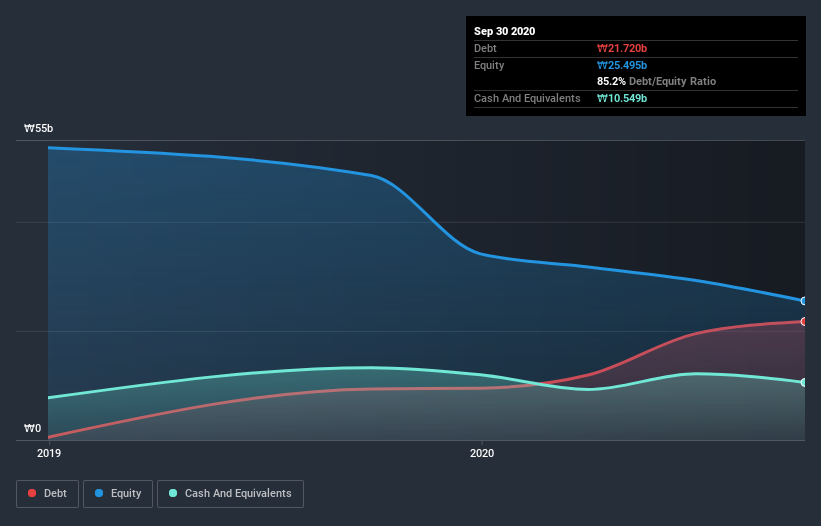- South Korea
- /
- Personal Products
- /
- KOSDAQ:A227610
Outin Futures (KOSDAQ:227610) Is Carrying A Fair Bit Of Debt
Warren Buffett famously said, 'Volatility is far from synonymous with risk.' So it might be obvious that you need to consider debt, when you think about how risky any given stock is, because too much debt can sink a company. Importantly, Outin Futures Co., Ltd (KOSDAQ:227610) does carry debt. But should shareholders be worried about its use of debt?
What Risk Does Debt Bring?
Generally speaking, debt only becomes a real problem when a company can't easily pay it off, either by raising capital or with its own cash flow. Part and parcel of capitalism is the process of 'creative destruction' where failed businesses are mercilessly liquidated by their bankers. While that is not too common, we often do see indebted companies permanently diluting shareholders because lenders force them to raise capital at a distressed price. Of course, plenty of companies use debt to fund growth, without any negative consequences. When we think about a company's use of debt, we first look at cash and debt together.
See our latest analysis for Outin Futures
What Is Outin Futures's Debt?
As you can see below, at the end of September 2020, Outin Futures had ₩21.7b of debt, up from ₩9.36b a year ago. Click the image for more detail. However, because it has a cash reserve of ₩10.5b, its net debt is less, at about ₩11.2b.

A Look At Outin Futures's Liabilities
The latest balance sheet data shows that Outin Futures had liabilities of ₩23.4b due within a year, and liabilities of ₩11.4b falling due after that. Offsetting this, it had ₩10.5b in cash and ₩6.00b in receivables that were due within 12 months. So its liabilities outweigh the sum of its cash and (near-term) receivables by ₩18.2b.
While this might seem like a lot, it is not so bad since Outin Futures has a market capitalization of ₩44.1b, and so it could probably strengthen its balance sheet by raising capital if it needed to. However, it is still worthwhile taking a close look at its ability to pay off debt. There's no doubt that we learn most about debt from the balance sheet. But you can't view debt in total isolation; since Outin Futures will need earnings to service that debt. So when considering debt, it's definitely worth looking at the earnings trend. Click here for an interactive snapshot.
Over 12 months, Outin Futures made a loss at the EBIT level, and saw its revenue drop to ₩48b, which is a fall of 7.1%. That's not what we would hope to see.
Caveat Emptor
Importantly, Outin Futures had an earnings before interest and tax (EBIT) loss over the last year. Its EBIT loss was a whopping ₩23b. When we look at that and recall the liabilities on its balance sheet, relative to cash, it seems unwise to us for the company to have any debt. Quite frankly we think the balance sheet is far from match-fit, although it could be improved with time. Another cause for caution is that is bled ₩12b in negative free cash flow over the last twelve months. So in short it's a really risky stock. The balance sheet is clearly the area to focus on when you are analysing debt. But ultimately, every company can contain risks that exist outside of the balance sheet. For example, we've discovered 4 warning signs for Outin Futures (1 is potentially serious!) that you should be aware of before investing here.
When all is said and done, sometimes its easier to focus on companies that don't even need debt. Readers can access a list of growth stocks with zero net debt 100% free, right now.
If you’re looking to trade Outin Futures, open an account with the lowest-cost* platform trusted by professionals, Interactive Brokers. Their clients from over 200 countries and territories trade stocks, options, futures, forex, bonds and funds worldwide from a single integrated account. Promoted
New: AI Stock Screener & Alerts
Our new AI Stock Screener scans the market every day to uncover opportunities.
• Dividend Powerhouses (3%+ Yield)
• Undervalued Small Caps with Insider Buying
• High growth Tech and AI Companies
Or build your own from over 50 metrics.
This article by Simply Wall St is general in nature. It does not constitute a recommendation to buy or sell any stock, and does not take account of your objectives, or your financial situation. We aim to bring you long-term focused analysis driven by fundamental data. Note that our analysis may not factor in the latest price-sensitive company announcements or qualitative material. Simply Wall St has no position in any stocks mentioned.
*Interactive Brokers Rated Lowest Cost Broker by StockBrokers.com Annual Online Review 2020
Have feedback on this article? Concerned about the content? Get in touch with us directly. Alternatively, email editorial-team@simplywallst.com.
About KOSDAQ:A227610
Outin Futures
Operates as a design and cosmetic development company worldwide.
Adequate balance sheet and slightly overvalued.
Market Insights
Community Narratives




